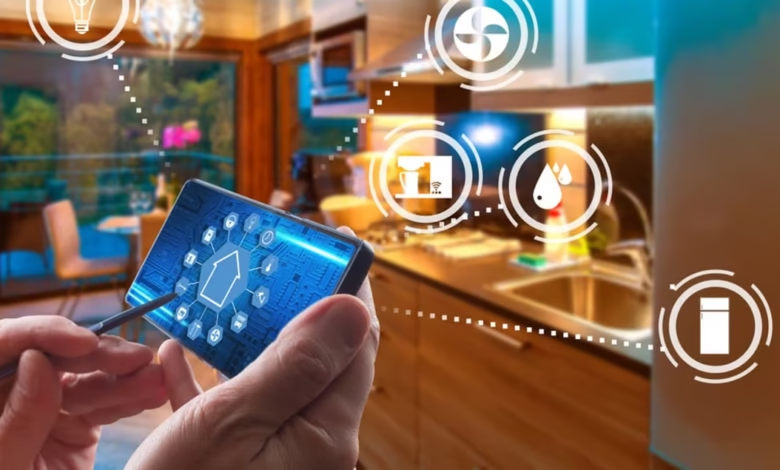The Future of Smart Home Technology: Transforming Your Living Space in 2025

Smart home technology has evolved significantly over the last few years, becoming an essential part of modern living. With an increasing number of people adopting smart devices to automate their homes, the future of home technology looks brighter than ever. In 2025 and beyond, smart home technology will continue to play a pivotal role in enhancing comfort, convenience, security, and energy efficiency in homes across the globe.
This article explores the benefits, latest innovations, and tips for integrating smart home technology into your living space. Whether you’re a tech enthusiast or someone considering the switch to a smarter home, this guide will help you navigate the exciting possibilities.
What is Smart Home Technology?
Smart home technology refers to the integration of internet-connected devices and systems into your home to automate and control various functions remotely. These devices can range from lighting and thermostats to security cameras, smart speakers, and kitchen appliances. The primary goal of smart home technology is to make everyday tasks more efficient, improve convenience, and increase security.
Key Features of Smart Home Technology:
- Remote control: The ability to control devices from anywhere using smartphones, tablets, or voice commands.
- Automation: Smart devices can be programmed to perform specific actions at certain times or in response to certain triggers.
- Integration: Devices can work together seamlessly, providing a connected experience where all systems can be controlled via a single interface.
Why Should You Consider Smart Home Technology?
The decision to adopt smart home technology can significantly improve your lifestyle by offering a variety of benefits. Below are the most compelling reasons to incorporate smart devices into your home:
1. Enhanced Convenience and Comfort
Smart home devices offer unparalleled convenience by automating mundane tasks. Imagine adjusting your thermostat from your smartphone before you even get home, or having your lights turn on automatically when you enter a room. These conveniences enhance your daily routine, making it smoother and more enjoyable.
- Smart lighting can be adjusted with a tap or voice command, allowing you to set the perfect ambiance in your home without the need for manual dimmers or switches.
- Smart thermostats learn your preferences and automatically adjust temperatures to ensure maximum comfort while saving energy.
2. Improved Security
One of the primary reasons people adopt smart home technology is to increase home security. Smart security devices, such as cameras, doorbells, and sensors, help you monitor your home in real-time from anywhere. Features like motion detection, video streaming, and instant alerts make it easier to keep track of what’s happening in and around your home.
- Smart doorbells like Ring or Nest allow you to see and communicate with visitors remotely, providing enhanced security when you’re away.
- Smart cameras can monitor both the exterior and interior of your home, and many can be accessed through your phone to check in on your property in real-time.
3. Energy Efficiency and Cost Savings
Smart home technology can also help you save money on utility bills by making your home more energy-efficient. Devices such as smart thermostats, lights, and power strips can automatically adjust based on usage patterns, reducing waste and ensuring that energy is used efficiently.
- Smart thermostats like Nest or Ecobee learn your schedule and adjust the temperature accordingly, ensuring you’re not heating or cooling an empty home.
- Smart plugs can help reduce standby power consumption, turning off devices when not in use, ultimately lowering energy costs.
4. Increased Home Value
As demand for smart home technology grows, homes with integrated smart devices are becoming more attractive to potential buyers. Implementing these technologies can increase your home’s market value, making it more desirable in a competitive real estate market.
- Homes equipped with smart lighting, security systems, and energy-efficient appliances are often considered more modern and appealing to homebuyers, potentially boosting the resale value.
5. Seamless Integration with Voice Assistants
A major selling point of smart home technology is its integration with voice assistants like Amazon Alexa, Google Assistant, and Apple Siri. With voice commands, you can control a wide range of devices, such as lights, thermostats, and entertainment systems, making your home even smarter.
- For instance, saying “Alexa, turn off the lights” can help you adjust your lighting without having to get up. Smart voice assistants bring a level of hands-free control that further enhances convenience.
Also Read: 5 Key Steps to Successful Digital Transformation for Businesses in 2025

The Latest Innovations in Smart Home Technology
Smart home technology is constantly evolving, with new devices and features emerging regularly. Here are some of the most exciting innovations in the field of smart home technology that you should look out for in 2025:
1. Smart Home Hubs
A smart home hub serves as the central control point for all your smart devices. While many smart devices can be controlled individually via apps or voice commands, a hub allows for more sophisticated automation and seamless integration. Popular options like Amazon Echo or Google Nest Hub offer multi-device control, allowing users to create custom routines or scenes that automatically trigger specific actions based on time, location, or other factors.
- Smart home hubs will become even more advanced, offering greater compatibility with a wider range of devices and more robust security features.
2. Artificial Intelligence (AI) Integration
As AI continues to advance, expect smart home devices to become more intuitive and proactive. AI-powered devices will be able to anticipate your needs based on patterns in your behavior, adjusting things like lighting, temperature, and even entertainment preferences automatically.
- For example, a smart thermostat might anticipate when you’re likely to return home and adjust the temperature accordingly, ensuring that your home is always comfortable when you arrive.
3. Voice-Controlled Smart Appliances
Voice-controlled smart appliances are becoming increasingly common in kitchens and living rooms. Devices such as refrigerators, ovens, and washing machines now come with smart capabilities, enabling users to control them via voice commands or apps. This feature is especially useful for hands-free operation when your hands are full.
- Smart refrigerators can provide reminders for groceries, track expiration dates, and even suggest recipes based on what’s inside.
- Smart ovens can be preheated remotely and controlled with simple voice commands, making meal prep more convenient.
4. Advanced Smart Security Systems
With the rise in demand for home security, smart home technology is revolutionizing the security industry. New smart security systems combine multiple features, such as facial recognition, advanced motion detection, and cloud-based storage.
- Smart security cameras equipped with AI can distinguish between pets, people, and other objects, reducing false alerts.
- Smart locks now offer features like remote unlocking, keyless entry, and temporary access for guests, making home security more convenient and customizable.
5. Smart Health Monitoring Devices
Incorporating smart home technology for health purposes is becoming increasingly popular. Devices like smart scales, air purifiers, and sleep trackers are integrating with home networks to provide data-driven insights into your well-being.
- Smart air purifiers automatically adjust based on the air quality in your home, helping to ensure a healthier living environment.
- Smart sleep trackers offer detailed insights into your sleep patterns, allowing you to make improvements to your nighttime routine for better overall health.
How to Get Started with Smart Home Technology
If you’re new to smart home technology, getting started can seem like a daunting task. Here’s a step-by-step guide to help you integrate smart devices into your home:
1. Identify Your Needs
Start by identifying what aspects of your home you want to automate. Are you looking to enhance security? Improve energy efficiency? Add convenience to your daily routine? Understanding your priorities will help guide your purchases.
2. Choose a Hub or Ecosystem
Most smart devices work best when they are part of a larger ecosystem. Decide whether you want to go with Amazon Alexa, Google Assistant, or Apple HomeKit, and choose devices that are compatible with your selected platform.
3. Start with the Basics
If you’re just beginning, consider starting with a few simple devices, like smart lights, plugs, or a smart thermostat. These are easy to install and can make a noticeable difference in your home’s efficiency and convenience.
4. Expand as Needed
Once you’re comfortable with the basics, gradually add more smart devices to your home. Over time, you can create a fully connected environment that enhances comfort, security, and energy efficiency.
Conclusion: The Future is Smart
As smart home technology continues to evolve, the possibilities for enhancing your home are virtually limitless. With innovations in automation, security, and energy efficiency, smart home devices are transforming the way we live. By adopting smart home technology, you can create a home that is not only more efficient and secure but also more connected to your everyday needs.
Start small, choose devices that fit your lifestyle, and watch as your home becomes smarter with each step. The future of living is here, and it’s time to embrace the digital revolution in your own home.






One Comment